#AGAIN I know it’s about the metaphors and the symbolism and the representation and the imagery and the cautionary tale and the whatever
Explore tagged Tumblr posts
Text
Honestly the worst thing about vampires is how disgustingly rich they are. Generational wealth on steroids. Yada yada metaphors you are thirsting over a landlord, Carolina.
#Preying on the poor on a whole new level.#Bloodsuckers but not only in the fun way.#And we read mopey tales and feel sad for them? This is the real tragedy.#Oh no my poor little baby blorbo burden with eternity and immense wealth and health and power and ridiculous physical beauty 🥺🥺🥺#AGAIN I know it’s about the metaphors and the symbolism and the representation and the imagery and the cautionary tale and the whatever#I know that. I know it.#Jeff Bezos wrapped in lace and literally drinking our blood is such a ridiculous idea AND YET.#Oh you eat bad people beloved? How very morally right of you now tell me why do we have so many billionaires around?#goth#gothic#romantic goth#dracula#vampire#vampires#dark#vampire literature#capitalism? idk.
10 notes
·
View notes
Text
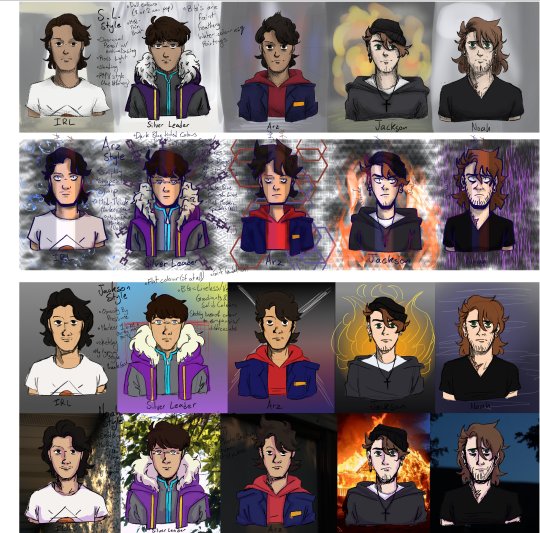
Working on a little (big) project, finally figured out the storyline I want to go with, that's all I'll say, it's called IYKYK. Literatly thats the project name, it might change but it's quite what it means. but if you don't know? That's okay too! I'm hoping to tell a compelling story anyways. This is probably gonna take a couple years to do though XD
If you are interested this is the playlist I'll be working with. Yes I'm planning on making video visuals for this project (I'd say animating but I'm gonna be using a bunch of different techniques, also animating is hard af and takes a long time and I'm not exactly an animator.) Also you get to learn a little bit of my music taste now XD
#snazum draws#snazum talks#original character#i want to explain it all so bad but also I don't want to put that dirty laundry out there. So it shall be a story that my irls know#and if friends who don't know want to know i'm more than willing to explain it!!!#seriously though I'd love to yap someones head off bout this project it's just a little heavy with the topics#okay fine i'm yapping in here vaguely#so i started this round half a year to a year ago probably to work through my emotions about everything#obviously now I'm in a much better headspace so it's less vent and more exploration and an autobiography through representation/metaphors#basically exploring it all through fictitious stories to explore my emotions without going into details about the events of my life#Yeah that's bout it :> that's why I say the project deals with heavy topics#obviously if u wanna hear more bout the project without the heavy details I can do that too!!!#I don't really want to get into the heavy details anyways. would rather just explain the emotional side and the intricacies of the project#I loveeee symbolism and metaphors and exploring the depth of human emotions and how we cope with our reality#specifically my human emotions and how I cope with my reality#but seriously i love human psychology it's just easier to write what you know lol#but once again this project did originally start as a vent piece so it has just shifted to a healing piece#also like. idk maybe if people like it enough (or i do) i may just explore the worlds of these ocs more in depth as well#maybe noah moreau can finally be detatched from m4ss 3ffect XD#sorry just don't want that showing up in the tag search love tumblr#Project: IYKYK
1 note
·
View note
Text
Double-Edged (?)
I got distracted by this while I was thinking about something else, but-
When you look the shapes Paracelsus takes in Strive when A.B.A's Jealous Rage is active, obviously it seems like the "blade" part of his body is reverting to a more ax-like shape and all:
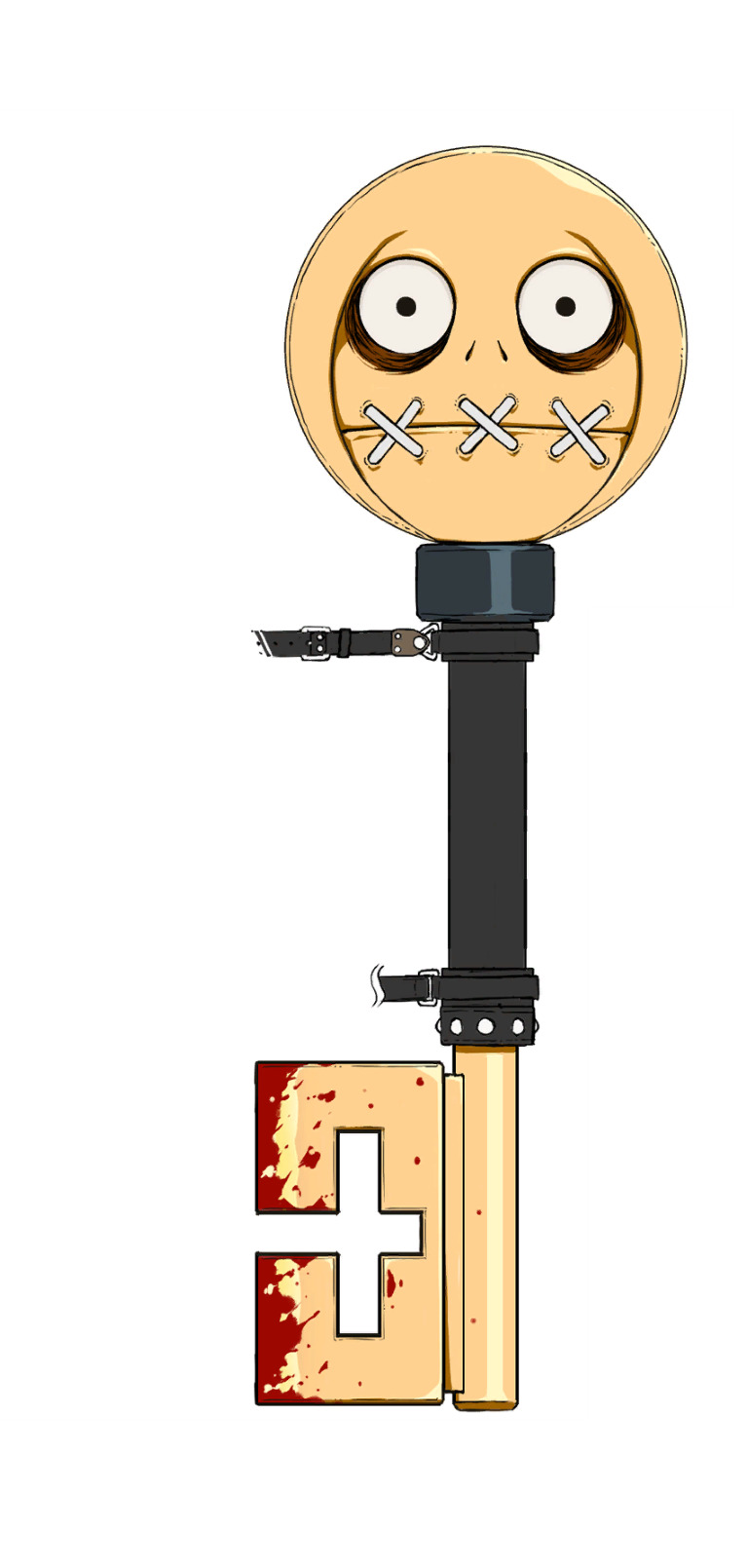
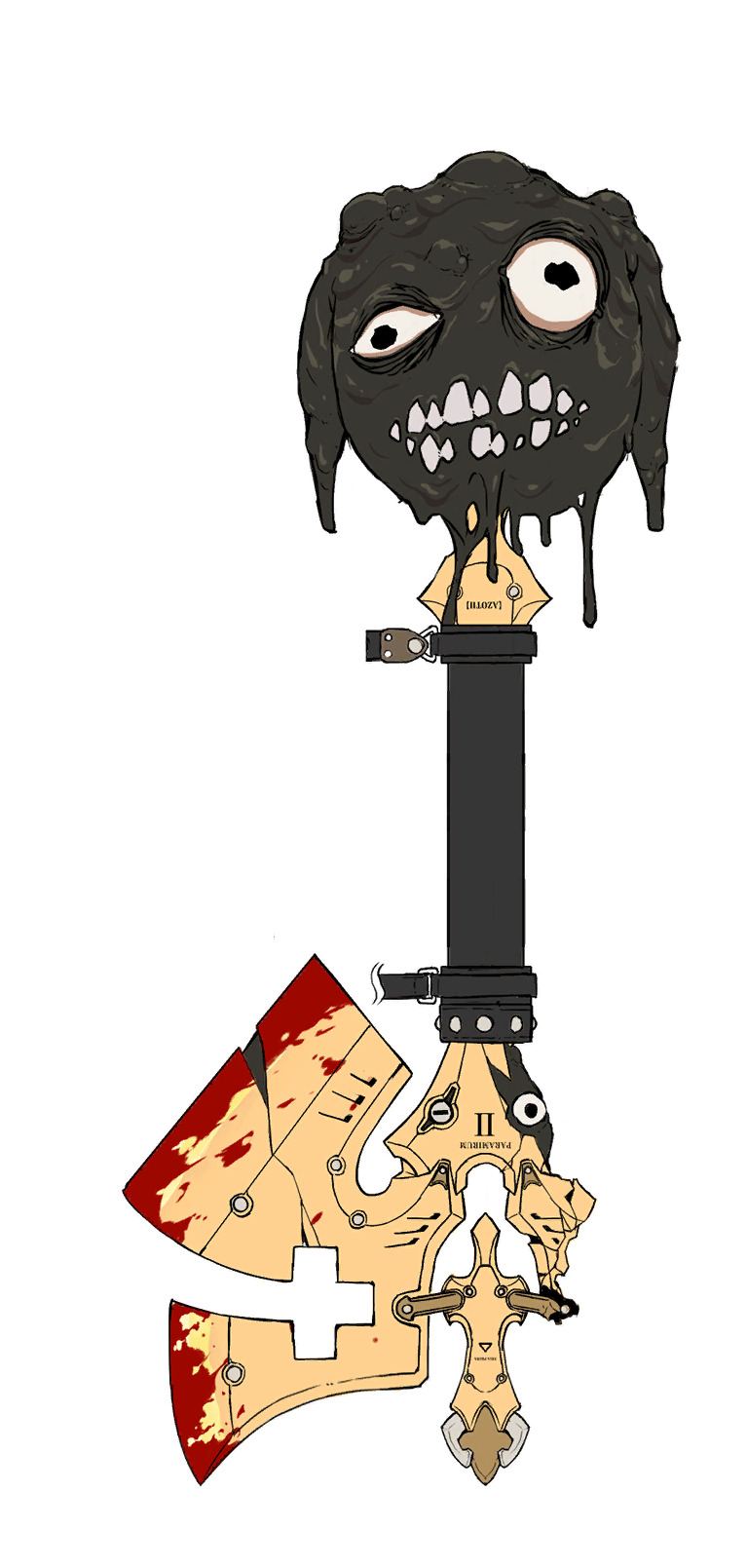
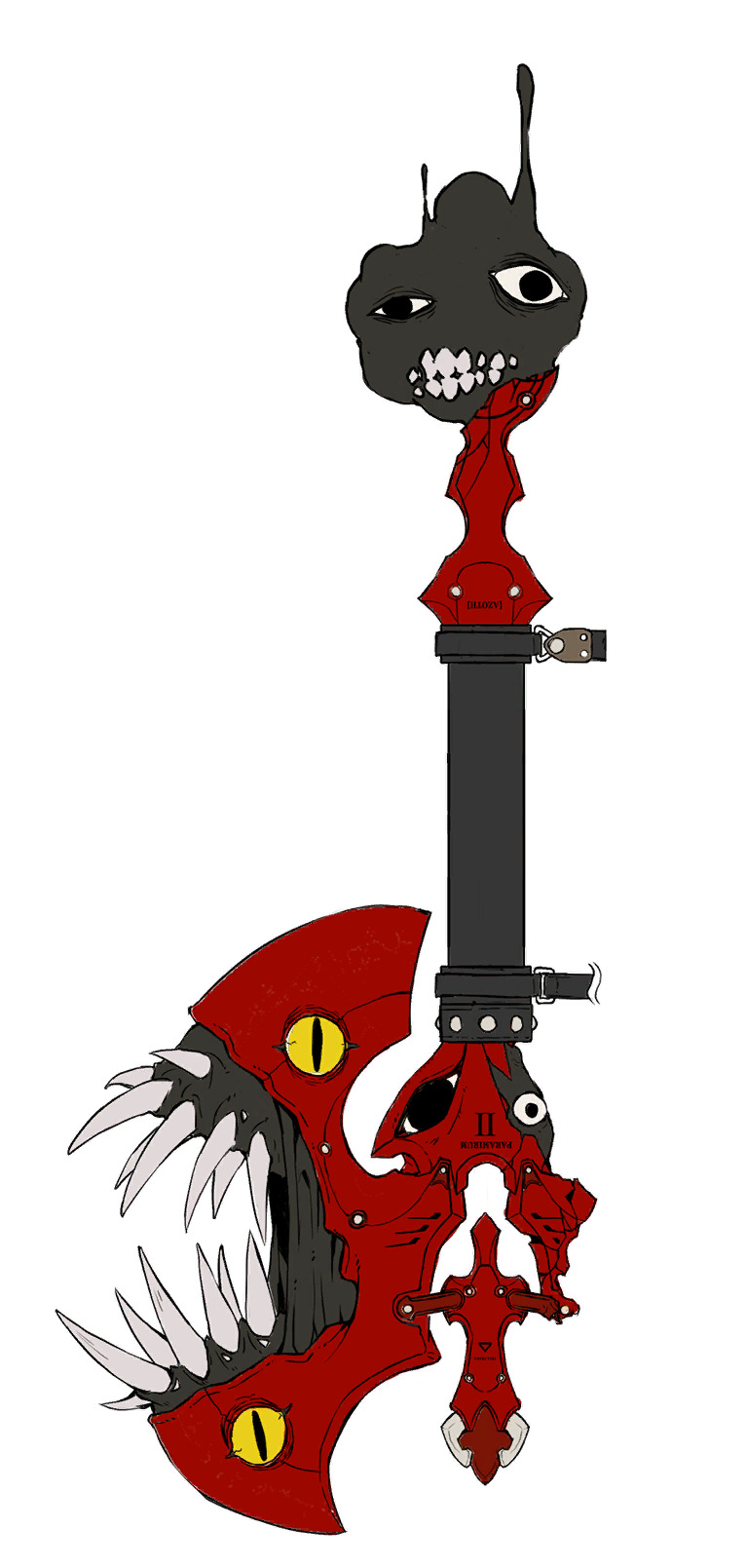
(there's a lot to talk bout here, but for now let me just focus on the thing that distracted me)
What caught my interest is that when you look at the blade part, it definitely looks like there was half of it broken off, like it's supposed to actually be a symmetrical, double-bladed battle ax:


Now, since Paracelsus' shape is constantly changing, obviously this might not be representative of any physical damage that literally happened, and could instead be a symbolic representation of something, but
I kinda like the idea now that Flament Nagel started out as a double-bladed ax, and half of it was broken off at some point over the course of his history, like maybe all the way back when he was still an actual lifeless ax, or maybe as late as during his first battle with Slayer?
I dunno, that's just one possibility, of course.
Just kinda continuing from that train of thought while I'm at it, I'm sure a lot of folks already know that "Moroha", (the name of the berserk state that A.B.A and Paracelsus would enter in the past games,) actually translates to "double-edged".
When Testament says this during A.B.A's Strive arcade mode, they actually use that same "moroha" wording in Japanese, making a fun little reference to the mechanic:
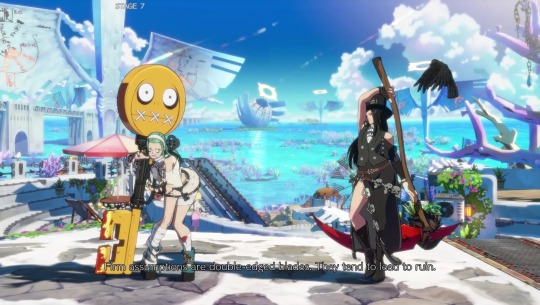
Obviously that name, "double-edged" is also like, alluding to the "high risk, high reward" nature of the mode back in the day, since the resources to use it were limited, and it actually drained A.B.A's HP (which could only be replenished if you knew how to play it well)-
but with what I talked about above in mind, it's also kinda interesting to think about how that name is applied to fighting with an ax that's actually single-bladed.
This is now going into full "just my own thoughts" territory, but looking at it from this additional angle, I kinda like to think that, metaphorically, it's like A.B.A herself is now the second blade, so to speak-
Both in the sense that she provides an extra means of attack and defense, and has a certain restoring/healing influence on Paracelsus, but also in the sense that she introduces another risky, potentially self-destructive element to the balance again.
#guilty gear#guilty gear strive#guilty gear strive spoilers#paracelsus guilty gear#a.b.a guilty gear#aba guilty gear#just talking#long post#cw blood#I suppose#maybe I can get around to writing about the thing I was actually thinking about too
431 notes
·
View notes
Text
Fire (1996): A Mostly Spoiler Free Pitch Because You Should Watch It Immediately
It's time for "An Indian QL bulldozed past my expectations and I am reeling in awe", Part Two!
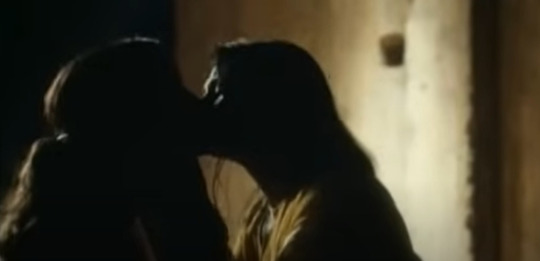
A few days ago, @neuroticbookworm told me about Fire, an old lesbian Indian movie she'd been wanting to watch. Me being me, I promptly tracked it down and settled in to watch it.
Very loosely based on the 1942 short story Lihaaf, the movie follows Sita, a newly wed bride who is settling in with her in-laws, which is how she meets Radha, who is married to her husband's brother. Both in unhappy marriages, they find solace and company with each other, quickly falling in love. Length: 1 Hour 40 Minutes TWs: Homophobia, C-word mentioned once, some depictions of domestic violence Release: 1996
The is almost entirely in English, and while one generally expects Bollywood movies to be in Hinglish, it's definitely a conscious choice here, which does make me wonder if the movie was supposed to be promoted to a greater international audience. You can find it here on Youtube, most of the (very few) Hindi dialogues have hard subtitles. I think it's also available on Prime? It wasn't available in India though, which is odd, but I didn't bother investigating. Let me know if anyone can figure anything out about this!
Going into this movie, I expected a melodramatic, emotional movie with a bittersweet tone. I did not expect a biting, incredibly engaging movie with excellent satire, symbolism, discussions of chastity culture, and an incredibly sweet, beautifully written romance. And I was certainly not prepared for how incredibly horny this movie is??? Both in subtle tension and overt sex scenes. There's also partial nudity, which again, completely unexpected. If you're going taboo, go taboo all the way I suppose. It's also very well directed, and while I'm not nearly as good at identifying details like that as some of the people on here, I did pick up on some colour coding and interesting framing. It's just overall packed with little details that I think a lot of us would have a field day analysing.
Honestly, I could talk about the cultural nuances in this movie for hours. Contrary to my assumption about the reasoning behind making the movie fully in English, the movie seems to rely on the viewer's understanding of North Indian customs to deliver a lot of it's messages, particularly with its satire, more on that below. While I don't think it's necessary to enjoy the movie, it definitely does add some meat to the story. Then again, I'm a biased party, so it'll be hard to determine just how many messages may be lost to someone from outside of India without someone to compare notes with (this is me shamelessly trying to get you to watch the movie). Honestly, I'd be 100% down to write a more detailed, spoiler-including post that goes into the implicit nuances if people are interested.
There's two main selling points for the movie; the incredible way it shuts down purity and chastity ideology and the absolutely adorable relationship between Radha and Sita. The movie is set on ruthlessly tearing down and emphasizing the ridiculousness of purity culture. A lot of the messaging is indirect and uses metaphors, but there's also several explicit scenes addressing the issue. It's one of the main themes of the movie and I'm almost convinced the real reason it's titled 'Fire' is the sheer number of burns it dishes out on this subject. The romance portion of this movie is one of the thing's that completely defied my expectations. It wasn't sad and dramatic, it was heartfelt and silly and adorable. There's several scenes of the two subtly flirting, laughing together and just being lowkey in love. But that's not to say there's no emotional depth—they're also there for each other and are quite vulnerable with each other.
The movie used a lot of metaphors, but my favourites were the almost satirical representation of mythological stories. In a religion as diverse as Hinduism, every holiday has two dozen stories behind it and each story has two dozen versions, so it's to be expected that you'll find a number of problematic or otherwise kind of ridiculous stories in the mix. The stories were told completely seriously, but the context of the movie highlights their absurd facets in a truly brilliant way. I'm not going to give too much away, but I will say, it was a delight to watch the juxtaposition of the myths and the storyline of the movie, particularly it's ties to the purity culture discussion. You'll understand when you watch it. I'm not turning this into a Hindu mythology lesson (yet) but one interesting tidbit is that Radha and Sita are both names of mythological figures; namely the partners of two of the most worshipped avatars of the god Vishnu: Krishna and Rama respectively. And I was overjoyed to find that their names do have relevance to the metaphors in the story, particularly Sita's.
When the movie was first released, there were massive protests against it, I'm talking hundreds of people storming into theatres to destroy them and drive away audiences. I don't know what to say here beyond this, but what I will say is that I think Fire is an amazing movie that absolutely does not deserve to be lost to the sands of time. I hope you give it a shot, and if you do, tag me in any posts you make about it!
Tagging people who seemed interested in recs from my last post, let me know if you'd rather I not tag you!
@lurkingshan @impala124 @bengiyo @letgomaggie @winnysatang
@watertightvines @nutcasewithaknife @blorbingqls @twig-tea
@waitmyturtles @cryingatships @benkaben @usertoxicyaoi
@befuddledcinnamonroll @flyingrosebeetle
#me when the sex scene gets more spicy than im used to: BOOB?!?!?#no but seriously. it's so good. it's positively delightful#both of the lead actresses also seem to be somewhat critically acclaimed and are also activists!!#i kept feeling like i had seen Shabana Azmi (radha's actress) somewhere but couldn't put my finger on it#asked a friend and remembered i saw her in the supremely mid Rocky Aur Raani which was somewhat popular i think#i have things to say about the ending too but i don't want to spoil it because it's so insane#burn (1996)#queer indian media#queer media#desiblr#recs#indian gl#gl#iql#movie recs#movies#queer movies
112 notes
·
View notes
Note
About the mizuki chapter 2, there’s smtg about niigo being represented by animals(rabbit, dog, hedgehog, cat). I was wondering if they used this representation/symbolism before, the only one I know is the last mizuki event
Mafuyu being a rabbit comes from her fes card story, which reveals that her favorite book as a child was about a black rabbit who snuck away from home because it couldn't sleep and ended up meeting a white bunny (sound familiar?). She doesn't remember the rest of the story though. It can be seen in her untrained Memories of Warm Affection card as well.
Ena mentions that she thinks hedgehogs are cute in Mafuyu's Elpis at the Depths of Despair card story. It may also be a metaphor for how Mafuyu sees her - she can be prickly on the outside, but she actually really cares for Mafuyu and is soft underneath that exterior.
I can't think of a story reference for Kanade being a dog, so once again I'm tempted to say it ties to how Mafuyu sees her. Dogs are friendly and loyal, and are the go-to animal for helping people.
Aside from being a reference to Kitty, Mizuki being a cat could also tie to how Mafuyu sees them - someone who's rather mysterious and keeps their distance from others.
191 notes
·
View notes
Text
Contemplating when blood is explictly shown in Milgram MVs and for what purpose. (Plenty of shots of blood and bloodied people below the cut)
Both of Muu's songs show a pretty clear-cut image of the murder, blood and all.


But it's interesting to note that, while Muu does show realistic blood in both MVs, in After Pain it's only for a single shot: most of the shots of Rei's body have her covered in a neon green liquid instead - the same liquid inside the hourglass. But in It's Not My Fault, while the hourglass does return, it's not used as a stand-in for blood this time, only showing realistic shots of blood at the scene.



Realistic blood is again shown in The Purge March and although this whole scene is metaphorical, it is highly likely that this is what the state of the actual weapon would have been.

Some of the blood in MeMe appears to be representative of real events (though the circumstances around the murder are still so vague I can't say for sure), but some of it is clearly over-exaggerated for dramatic effect and not a representation what literally happened.



Sometimes blood is purely symbolic, like in Cat (in addition it is coloured pitch-black, even on Hinako's face when the lighting should make it appear brighter).


Similar to the above, the blood in Bring It On is symbolic of Fuuta's guilt, but is portrayed with more realistic colouration.


Then you have Haruka's weird midground, where he has blood in both his MVs, and both are heavily stylized (albeit in different ways). If the shot at the end of All-Knowing and All-Agony is any indication, he strangled his victim which should have been a bloodless death, but he has engaged in literal bloody activity before (killing pets), so his blood appears to be both metaphorical and literal.




At the end of Deep Cover, Kotoko stands covered in neon pink blood, chess pieces representing the other prisoners scattered about her feet. But the only pieces that are shown are those voted Innocent in T1 - those she has not yet attacked. So the blood here is not representative of any particular event, but rather her intentions.




But if that's the case, what does that say for Double, which portrays John standing in a train, dripping with blood the wrong colour as he attacks mannequins? Is this merely a mental block he has because he cannot clearly remember the events? Or, like Kotoko's similar theming above, is it purely metaphorical, indicating his emotions rather than his actions?




Then we get to Milgram Enigma Number 1, Mahiru. I Love You undoubtedly shows realistic blood, but whether it is literal or not is left very unclear. If the only bloodstain present was the one on his torso I'd be more inclined to believe it was truly all a metaphor; a betrayed or bleeding heart. But that doesn't explain the stain on the sleeve. And of course, it begs the question: if it is metaphorical, what is it representing? Fuuta showed guilt by recoiling at the blood on his hands, and Kazui showed remorse and how he feels like a monster by tearing a dove apart. But we don't see Mahiru cause this wound, nor does she react to it. As of right now I don't understand enough about Mahiru to form a concrete conclusion but if the trend in the other MVs is anything to go by, I'm afraid that these bloodstains might be more literal than I want to believe.


Interesting to note that Fuuta is the only character to show blood in his T1 MV but not the second, and both Yuno and Shidou show no blood in either MV (ironically enough for Shidou, as things like rotting fruit have to take the place of organs and blood instead)
#nooo the hiatus isn't affecting me I don't know what you're talking about#I just can't get a handle on Mahiru no matter how hard I try#praying she survives just so I can get some closure#milgram#milgram project#muu kusunoki#amane momose#mikoto kayano#kazui mukuhara#fuuta kajiyama#haruka sakurai#kotoko yuzuriha#john milgram#mahiru shiina#blood#tw blood#cw blood#murder mention#blood cw#blood tw
53 notes
·
View notes
Text
The Story/Secret of Us
So I believe I may have just solved a major piece of the puzzle and finally figured out WHY the tortured poets have been sending us these anonymous messages to help us solve it. I think this entire rabbit hole is a gift to us true fans which is why we got all of those cryptic present 🎁 anon messages. Alllll of these songs are dedicated to us (except for So High School and I will explain why I think this in more detail later). THIS is The Story or Secret of Us. The "secret" is this rabbit hole of connections and this secret language or code of symbols and metaphors we've all learned how to speak (sunshine/daylight/gold/yellow = Karlie/being out of the closet/queer love/happiness, 3 = Speak Now, orange = karma, etc). The "us" is the tortured poets and us true fans who share this secret language.

Another important part of understanding this puzzle is that some of these songs are time sensitive 🕰️ and like a prophecy (The Prophecy) waiting to be fulfilled. So after a certain point, some songs can no longer be applied bc that "scene" in the movie has already passed (If This Was A Movie). They want us to essentially play our part in the story they've written. Right now we are playing the part of Paul Revere or Cassandra warning swifties of what's coming (likely on Sept 28). And we're also acting as Taylor's wings/angels catching her when she falls off her pedestal (see this post). They want us to think of these moments when we listen to these songs bc they want them to be personally relatable bc that's part of our gift. I think this is what Taylor meant when she said
"Let me tell you my secret little dream for this evening. These are songs that I have written about my life or things I've felt at one point in time, whether I was a teenager, in my 20s, or a couple yrs ago. But after tonight when you hear these songs out and about in the world, my dream is that you're gonna think about tonight and the memories we made here together" (x)
and what present anon meant when they said
"Reach those lanterns a little bit higher. For you shall receive a metaphor so dire" (x).
"Then the actors (us true fans and the tortured poets) were hitting their marks and the slow dance was alight with the sparks and the tears fell in synchronicity with the score" // "It's a normal thing to fall in love with movie stars when the lights are low and red at all their favorite bars. And the story you want is the story you get. Are you special or was this all scripted in his head?...Don't worry, I know I'll see you again. Uh-huh, you'll make me cry when it comes to an end. You were all that we hoped (The Prophecy), but I can't recommend getting close, I should've known, but I'll see you again" (x). The tortured poets have invited us to "dance" with them by being a part of this movie. If we accept this invitation, then we essentially become the muse of these songs.

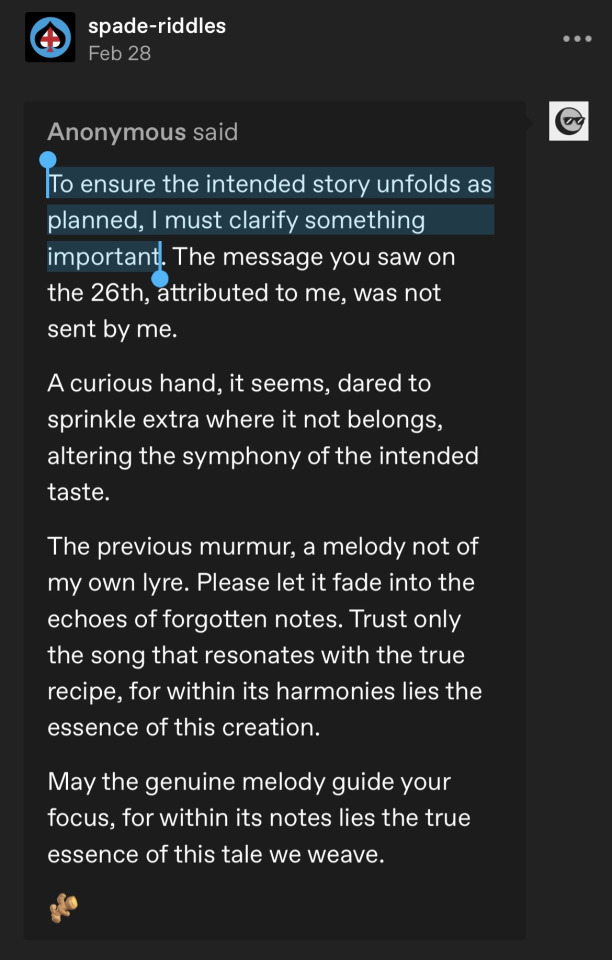



I think Gracie playing In Between as a surprise song on 9/19 was an easter egg for Lizzy’s song Pushing It Down and Praying that was released 9/20. I think the mv for this song is the visual representation of the 🫚 message about the audience member (us true fans) becoming a part of the magic show and also the teenage love triangle in folklore. In this story, we are playing the character Wendy/Betty while the tortured poets play the character Peter/James. Swifties or the fans who don’t see this metaphorical story are Augusta/Augustine, the girl that James cheats on Betty with in august. So even though the teenage love triangle is technically fictional, there are seeds of truth in it. This is what Taylor was trying to explain during the eras tour betty speeches when she said she created these fictional characters and she was acting as the narrator of their story (x). Role Model, who stars in the Pushing It Down and Praying mv, is also the opening act for Gracie's TSOU tour which is another connection.









And to add even more evidence to this theory, the teenage love triangle also makes an appearance in Gracie’s discography. Gracie has a song called Augusta on TIWIFL which just so happens to be the name of one of the characters in the love triangle. It is also the name of a town in Maine which is where Gracie’s family is from. There are 3 songs in total on TIWIFL that are named after towns in Maine—Camden, Augusta, and Rockland. If you put the first letters of these songs together, they spell out “CAR.” “Standing in your CARdigan, kissing in my CAR again,” “And when I felt like I was an old CARdigan under someone’s bed, you put me on and said I was your favorite," 2:46 in betty ("She said 'James, get in, let's drive'") corresponding with 2:46 in august ("Remember when I pulled up and said get in the CAR").


august, betty, cardigan (the 3 sides or perspectives of the love triangle) are “ABC” bc the alphabet or capital letters are one of the major keys to solving this puzzle. As I mentioned in this post, I think Audrey has been helping to plant easter eggs. She posted Capital Letters by Hailee Steinfeld on her insta 3 times which is quite interesting and she also included this song in her Summa playlist.




What makes this even more suspicious is that she specifically chose timestamps in the songs (1:11 and 1:23) that have these lyrics ⬇️ and she posted the 1:11 timestamp TWICE which indicates that she really wanted to emphasize it. "God I'm jumping in the deep end, it's more fun to swim in. Heard the risk is drowning but I'm gonna take it."


Another thing that I think ties in with all of this is the Stephen Colbert interview. In this post below, I explain why I think the pizza on the mood board represents PR/bearding/showmanship/magic. I also explain how the letters that spell out Stephen's name are a huge clue and are related to the Peter Pan metaphor that is a through line in both Gracie's and Taylor's music. This is another example of "capital letters" or the alphabet being the key to solving the puzzle.
Going back to what I said in the first paragraph, this entire rabbit hole of cross-referenceable songs is dedicated to us except for the "pizza" So High School which is the one song she dedicated to 🏈 This is why Taylor's mood board had one slice of pizza while every other picture was of Stephen.
#rabbit hole#mass coming out theory#stephen colber#peter pan#lizzy mcalpine#role model#augusta#capital letters#teenage love triangle#ginger#present anon#so high school#pizza#august#betty#cardigan#camden#rockland#pushing it down and praying#in between#paul revere#cassandra#the story of us#the prophecy#normal thing#if this was a movie#Spotify#Youtube
28 notes
·
View notes
Text

The quiet sexual assault symbolism in Metal Lords.
[TW] Discussion of SA, SA aftermath, and SA symbolism.
Every time I've written about these scenes I've felt like I had to hold back. But fuck it, right? I was inspired by this ask to actually share a bit more of my thoughts on the topic.
I can't overstate that I don't think any of this was intentional. I don't believe the scene was ever supposed display any more explicit SA, I think it's all purely accidental. Which, if you ask me, tends to be where the best emotional representation happens.
There's two scenes that unintentionally mirror the typical portrayal of sexual assault and its emotional aftermath. The scene where Skip attacks Hunter, cutting a chunk of his hair off. And the following scene where Hunter shaves the side of his head in his bedroom.
How many times have we seen female characters cut their hair after an abusive relationship or after being assaulted? And how many of us, regardless of gender, have done the same? Hacking away at our hair with blunt scissors and tears in our eyes. Standing over the bathroom sink trying to somehow cut out the memory.
And we know the likely "why" to the typical post-trauma haircut. It's looking in the mirror and seeing something other than the person that endured the trauma. It's taking back control over our bodies.
Before the attack even happens, Hunter's been slowly losing the control that he at least thought he had. Control over himself, his surroundings, and not to mention: Kevin. Kevin's pursuit of Emily creates an important crack in Hunter's perception of their relationship. And is evidence of the lack of control he really has over it.
Everything about the attack screams accidental SA metaphor. He's ambushed by several guys, overpowered, "gagged." A piece of him is taken, only to be discarded. Because it was never about the thing that's taken, only that it's violently ripped away. And afterwards he's left writhing on the floor. Eyes wide in disbelief. Trying to process what just happened to him.
That scene in isolation already has this theme thoroughly woven into it, but I think it's really hammered home in the one that follows.

Of course, Kevin is there with him. The person he feels most comfortable around. The person he needs now more than ever.
Not only does Hunter directly call Skip's coach a rapist before lamenting that when Skip & his friends come back they'll "ass-rape" him. (Again, I don't think that's a literal accusation, but the fact that that's where his mind went in at the very least notable.)
More importantly: he blames himself.
Kevin justly points out that Hunter didn't "get them suspended." They got themselves suspended by attacking Hunter. But he pushes back. Pointing out that he flicked Skip in the face first.
Let's not let it slide how much of a batshit escalation Skip's actions are. Even if we take everything entirely at face value, Skip is fucking unhinged. As most bullies are.
The fact that Hunter flicked Skip in the face in no way justifies him literally hacking off a chuck of Hunter's hair. But the fact that Hunter tries to justify it as being his fault brings it that much closer to the SA symbolism. It's painfully common for us to assume we must have done something to warrant the abuse we face. That we made the fatal mistake that led to it all, rather than it being a decision made by our attackers.
Obviously, at face value, Hunter shaving the side of his head is a logical way to deal with a chunk of his hair being cut off. It's that or cutting all of his hair off. Part of me feels like that's what Skip would have been hoping for. So choosing the shaved side instead feels like a subtle(ish) "fuck you" in and of itself. It's Hunter reclaiming his hair.
It's also that step towards regaining control. It's destruction on Hunter's own terms. (cough see the fucking jacket post cough) (and for that matter my other haircut post)
It's removing Skips fingerprints in favor of the scratch-marks of Hunter's own nails. Because by fuck is the stinging those leave preferable over the dull aching memory of Skip's hands on him.

For a split second we see him realize even a sliver of the impact of it all. When he's no longer able to distract himself by focusing purely on the act of shaving his head, he can't ignore what's directly staring back at him. That he's not the same as he was anymore. He's a different Hunter from the one that woke up that morning. He's been defiled. Destroyed. Partly by his own hand. Which doesn't exactly dull the sting of it but it at least makes it his. At least he has ownership over his damage. At least some of it's on his terms.
Of course the thing he turns to to snap himself out of this is to seek Kevin's approval.
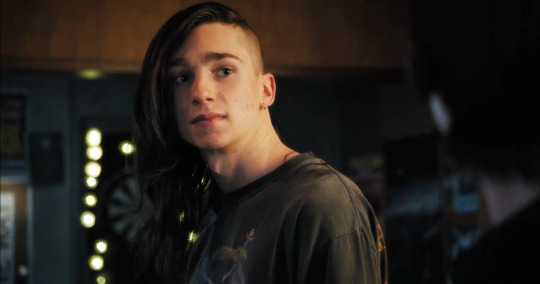
A plea, perhaps. Tell me I'm not as broken as I feel. Tell me I'm not completely destroyed. Tell me I'm going to come out the other end of this. Tell me you still love me.
(I'm aware this scene is played relatively lighthearted, and that I'm in fact insane. Water is also wet.)
I think that's all I have on this for now. Might add more later idk
#hunterposts#hunterwriteswords#cw sa mention#cw sa implied#tw sa mention#sa tw#sa mention#metal lords#hunter sylvester#skip hoffman#idk why it's “quiet” I just thought it sounded good tbh#metallords#character analysis
52 notes
·
View notes
Text

@hajimedics revealing my #anonymous self to show how ur post inspired me 🫡
ok I guess I will explain what the symbolism in this drawing means under this cut now :)
BASICALLY Rave’s tags on his art got me thinking about mutual sentience theory & the idea that who these puppets actually are does not align with what playfellow workshop created them to be — specifically, the actual desires of the puppets in whps are not the same as what playfellow thinks they should desire — and it made me think about how it might apply to Frank & Julie.
We know that neither of them fall into (strictly) binary gender labels, we know that Frank is gay, we know that Julie was confirmed sapphic in a stream — and yet we see playfellow putting them into the roles of cisgender heterosexual man & woman respectively, that they cast them to be in the roles of each others romantic love interests (see julie-rella animation cels). So I wanted to draw something based on that concept, the contrast of who they are vs who they’re “supposed” to be.
This is why I included 2 Franks and 2 Julies here, one set in my usual style for drawing them and the other being more ‘on-model’ — the former are a representation of who the puppets actually are, with their agency, while the latter are who playfellow themselves outline the puppets to be. The playfellow puppets are a ‘perfect’ version of sorts, their canonical accuracy + their sparkling appearance being extensions of how true to the script they are.
The framing of these two sets, how they interact with each other within the image, is meant to show the situational helplessness Julie and Frank share. They are stuck together in a ring of lavender flowers (do you get it. wedding rings. lavender marriage. I’m a master of artistic metaphor /j), looking to one another in worry as they’re surrounded by playfellow’s expectations. Neither of them want this, for themselves nor for each other, but what are they meant to do? They aren’t trapped by something they can just escape from, they’re trapped by their own identities; the will of their creators and the will of themselves are intrinsically linked, each at their core are answers to the question of who “Julie Joyful” and “Frank Frankly” are, to try and sever that connection is an impossible task.
The circles above each of the on-model puppets’ heads are primarily meant to be halos bc well. you know how queer religious trauma goes (there’s a ‘playfellow workshop is a stand-in for american christianity and possibly god’ metaphor in there somewhere) BUT they are also supposed to represent wedding rings too, to show yet again how playfellow likely wants them to be a couple — and not in the “a couple of bestiesss(๑>◡0)~☆” way they’d like to be
I think that’s all????? not really much else I can say here. background is black + slightly red for that whrp undersite feel and the on-model puppets are drawn in white to contrast with the primarily black background but also because they’re technically Julie & Frank’s straightsonas & black+white=straight pride flag. ok bye
#I elaborated on my thought process under the cut but erm idk I might sound insane..#pov you see me buying Frank & Julie angst at the delusional store#frank frankly#julie joyful#welcome home#welcome home fanart#welcome home puppet show#my art#don’t tag as ship#playfellow workshop said bury your gays?? nahh bitch bury them in the CLOSET more like#eyestrain#cw eyestrain#<- noticed that this image is kinda hard to look @ so I’m adding tjis now srry abt that!
193 notes
·
View notes
Note
Hello! Another day, another ask from yours truly. I was wondering what the "first knife" is? I've seen a few people mention it in relation to the shot of the veiled figure holding the shard of glass from the launch trailer, and i've never heard of this in lore. But it sounds pretty important, so now I'm curious. Thank you :)
It's referring to one of Unveiling's pages, called The First Knife. So the easiest and shortest answer is: we don't know! :D
But people have been speculating and trying to decipher it for years, as with all things from Unveiling, which I believe is a little bit of a futile thing to try and do because Unveiling is a metaphorical religious text. Essentially. It's been recently strongly implied that this text was written by the Witness pretending to be something else and using its lies and metaphores to convert the Guardians to its side (Unveiling was first released during Shadowkeep, before we knew about the Witness).
In The First Knife page, the author of the text is continuing with the explanation of, basically, how the universe began, through allegorical language. The Gardener and the Winnower argue about how things should be, the Gardener decides to insert itself "into the game" (the universe?) and this makes the Winnower "discover the first knife." It appears to be an allegorical way of saying that concept/idea of violence was invented, essentially. More under for length:
The Winnower appears to represent a specific concept that the Witness is pushing for which we know better as the sword logic: you have prove your right to exist and if you can't, you will be killed and therefore you never mattered at all. The Hive used this philosophy to eradicate countless of species, and so did the Witness with its disciples. This philosophy of winnowing is something that the Witness' species felt like was necessary in the universe to give meaning to everything that exists; there cannot just be the "meaningless" creation of the Gardener, there has to be a Winnower who will enact the violence and cull those that aren't worthy of existing.
The First Knife in that case would be a sort of a symbolical representation of the winnowing and how it all started. This is also referenced again in the lore book Inspiral, from Lightfall, in the page called Winnowing (last two pages of Inspiral read like a continuation of Unveiling):
It is the winnower that discovers the first knife, but it is not done without the gardener. This, too, is a tradition: a knife does not come to exist without something that must be cut. A woody stem, a colored petal, a vital vessel. The first victims of the blade.
It goes on to end the whole lore book with:
There can be no gardens without knives.
Which to me sounds like an attempt to convince us that the universe cannot exist without those that would do what the Witness is doing. That someone has to winnow, someone has to use the knife to cut things away. And to add to that, it could also reflect this idea that all of life is suffering, that there is no meaning to anything anyone does, that most lifeforms aren't worthy of existing and that a winnower in the universe will makes things better. That the universe should be made better by bringing on the final shape.
Seeing that veiled figure (which may be representing the Witness' species) with a shard of glass/rock (?) that looks like a sharp threatening object (knife?) sparked people's imaginations! It could be a representation of this concept, perhaps, or something completely unrelated. But the appearance of the veiled figures is so interesting because until now we've not had any explanation for them, other than their connection to the Pyramids/Darkness.
Now, at least from the few trailer shots, it seems likely that they represent the Witness' species or that they're in some form connected to that or some other symbol from the Witness' time as a civilisation. We've seen them as statues with the Witness' species and in all Pyramids. Curiously, the one in the Witness' flagship Pyramid appears to be tucked away in a hidden room, as if the Witness did not want it in a place of prominence; possibly signifying its attempt to detach itself from its roots? This is my old post about it before we knew of the Witness' origins.
We might find out some concrete information about the veiled figures in TFS; that would be really cool! They've been a sort of a constant since Shadowkeep and have been the cause of many debates and much speculation! Nothing I said here is in any way conclusive or final, naturally.
In any case, that image of the veiled figure with the sharp object could be a representation of a member of the Witness' species with the first knife, symbolically showing us how they discovered the philosophy of winnowing and dedicated themselves to it so completely that it turned the entire civilisation into this malicious angry entity.
A lot of people are also once again speculating that this could be representing the Winnower, a separate entity from the Witness, similar to the Gardener (Traveler). This is something a lot of people expected and wanted ever since Unveiling was revealed which was always a little bit weird to me because Unveiling openly describes itself as an allegory. A lot of people were disappointed that the Witness was shown as our big bad and some still expect there to be something even bigger and badder than the Witness, which I just don't think would make sense or would be beneficial to anything.
The story of Destiny has always been about choice. Repeatedly throughout every piece of information we've been told over and over that Light and Darkness are tools; they do not inherently tell us anything about their wielders. Using the Light does not make you inherently good, as we've seen from the stories of early Lightbearers; bloodthirsty violent Warlords. And more recently, as we've started learning more about Darkness, it repeatedly became apparent that simply using the Darkness does not make you evil; from the creation of the Awoken, through Drifter's Gambit, and all the way to Stasis and Strand and all the extra information about the Darkness and its users throughout the universe, we've known that this isn't an evil force by default. This was fully and completely confirmed in Lightfall; Light and Darkness aren't opposing moral forces, but the Witness desperately thinks they should be so it shapes itself to oppose the Traveler.
So there being a Winnower that governs all of Darkness which is an even bigger enemy to us than the Witness would just be bizarre to me, because Darkness is not inherently anyone's enemy. It's much bigger than that, as a fundamental force of the universe, as much as the Light is; it is our choice to use it that turns it into what it is. Our choices give morality to our tools, not the other way around. I personally really enjoy this because it creates a much richer world where you can't simply point at a Darkness user and say "evil." Darkness as a force of memories and emotions and history and thought and consciousness is so much more interesting to me than there being some evil Winnower. The Witness misinterpreting this and twisting the Darkness into just being "winnowing" is so much more fitting because it's about choice: the Witness' species chose to do that and they were wrong.
The "knife" allegory fits here as well, because a knife is not inherently good or bad; it's about your choice how to use it. The Witness chose to use it as a weapon.
Obviously, as I said before, none of this is final or complete. And who knows? It's possible that some information may be revealed in the future that turns everything upside down again and maybe there is another entity somewhere. But I'm mostly interested in the stuff we do know, rather than "what if" speculations simply because if we go by that, we could make any option sound true and plausible.
Also, in one of the early lore pieces, a grimoire from D1 which is from the POV of the Traveler, also mentions this imagery of a knife:
The knife had a million blades. And you were giant, powerful and swift. But the knife pinned you. Cut your godly flesh away. ... The knife stole much more than your body.
This is the Traveler most likely recounting the Collapse. The whole "knife" thing has been mentioned a lot throughout the lore, though only in these fairly metaphorical pieces. However, people have been looking into it for a long time and Unveiling turned this whole thing into a big debate and point of speculation. Inspiral reignited it 4 years later and now we also got this brief little snippet from the trailer so everyone is out here losing it and will continue losing it until we finally play. I am honestly hoping that some of this will never be fully explained and that some of it will always remain in this state of almost religious metaphor.
So long answer? We still don't know. But it's something people love thinking about and debating so this is why everyone is discussing it and how it might relate to that phrase, "the first knife." A lot more could be said as well, probably triple the size of this post.
Highly recommend (re)reading Unveiling, but also Inspiral and TFS CE. Unveiling remains my favourite lore book of all time, because to me, it only gains in its brilliance the more people question it. It's such a unique piece of writing that can be a complete lie, a complete truth, or something in between, depending on who you ask. It's a mythology without full context, a religious text and propaganda, possibly with some truth sprinkled in. And we may never know which pieces of the text are which. Perfect.
#destiny 2#destiny 2 spoilers#the final shape#the final shape spoilers#unveiling#witness#user thefirstknife has much thoughts about the first knife#i also have the unveiling tag where there's a lot of other posts with discussions about stuff like this!#especially after the witness origins cutscene#lore vibing#long post#ask
30 notes
·
View notes
Text
okok so if you have visited my blog at all ever you will probably know that i am very interested in district nine and i never really explained why, so here is my silly little analysis/explanation of my d9 interest.
so, to me, district nine was a missed opportunity (or, just a very silent representation) of a metaphor. i know that thg is allegorical, and the intricacies of the lore and world building don't necessarily all have to add up into one perfect picture. it isn't "underdeveloped" when there was no need to develop it in the first place. this is just a personal collection of thoughts.
in the hunger games, there is a recurrent motif of bread being a symbol of hope. its seen time and time again, the most common example being peeta burning bread on purpose to give to katniss when she is on the brink of starvation. other examples include when district eleven all banded together to buy katniss their specific district bread as a sign of thanks and, further on the "district bread" subject, sending the bread as a gift during the 75th games with secret codes and messages for rebellion.
bread is so deeply engrained (ha, see what i did there) into the hunger games' lore that the location is even called panem, stemming from 'panem et circenses', latin for bread and circuses. the phrase was coined by juneval, a roman poet, who used his poetry as satirical commentary on roman society. he is referring, in this passage, to the roman practice of giving free wheat to the citizens, and putting on circuses in order to distract them so leaders could gain more political power.
this very obviously and intentionally mirrors the tesserae system, with the wheat/grain only being "free" if you give up one slip of your name to be entered in the reaping. the "small" price to pay.
how does this link in with district nine, you may not ask?
district nine's whole thing is bread and grain. i at first thought that it was strange that they made a whole other district JUST for bread and grain when district eleven was right there.
the reason i came up with in my head for this, was that it is a (intentional or not) parallel to the society juvenal is referring to. panem is so focused on bread, so desperate to churn out more and more as gifts, as grain, as food for the capitol, that they needed a whole district just to manage the supply.
this doesn't make district nine special by any means, all of the canon tributes from district nine do not survive the blood bath in the games, and there are only two named characters (with names relating to bread/grain, i may add).
the metaphor in my mind is that the most irrelevant district is given the bread role, something that is meant to be special that they can use for propaganda. this is the wheat. this is the helpful and free distraction that attempts to brainwash them to forget about the capitol's crimes (the gaining of political power, in juneval's terms). this could be why, in the end, district nine never became part of the rebel plan. maybe they gave this role to district nine because of them being involved in a rebel plot previously (in tbosas, it mentions jabberjays being sent to districts 11 and 12, known for being rebellious, but also 9).
the bread and grain produced from the hands of district nine's workers is used to starve them. they can only get food if they work vigorously or sign up to end their life, but they are so focused on staying alive, on getting the free wheat that juneval refers to that they forget and are distracted by the circus, which is the game all along. starve them enough to keep working, make that their end goal, and use that as a distraction to gain political power.
it's a kind of morbid irony that the district that works so hard to provide bread, the soul focus of panem, is one of the most starving.
#have not proofread this so it may make no sense at all#thg meta#thg analysis#the hunger games#the ballad of songbirds and snakes#district 9#district nine thg#bel rants
21 notes
·
View notes
Note
is nezha eternally 12?
yeah he is he told me himself in a t&t parking lot
12 is an arbitrary number. if you're looking for a source that literally says the exact phrase "nezha is eternally 12" you're uhh probably not going to find one. you're also probably not going to find a source that outright states that he grew into an adult. i think the reason 12 has become a popular number is because it sort of straddles that point between true childhood and adolescence, but again, it's arbitrary.
in fsyy, nezha is 7 when the whole thing with ao bing and returning his flesh and bones to his parents happens, which as far as I'm aware is the last time that an exact age is given for him in that particular novel. fsyy is also not the end all be all of "canon", but it did have significant implications for both practiced religion and literature (1, ch.5). sangren also notes that 7 being the age given is important.
i've only read about half of jttw so far, but don't think any physical or chronological age is stated for him, except that sun wukong calls him "小哥" (little guy/young man/etc.) when they first meet lol.
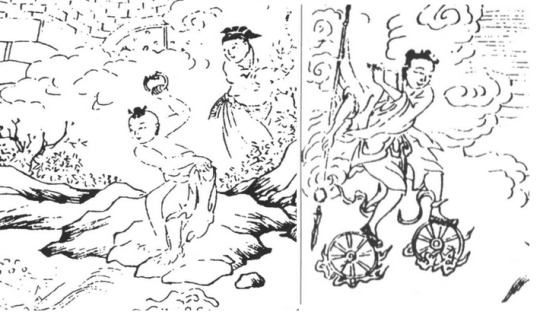
(a couple of nezhas from this copy of fsyy)
but the exact number of 12 isn't the point behind the statement. imo the idea behind the sentiment is that nezha is culturally perceived as a child. he is metaphorically and literally associated with and representative of the traits and struggles of childhood. he is "the most popular and classic cultural image of child personification in the literature of China" (2). the portrayal of the child - what traits they embody, which authorities they subvert, how their agency develops and affects the world around them - will change with the sociopolitical environment of the country, and portrayals of nezha have always changed along with it, for the reason that his image is inextricable from that of a child's (3, 4). he is a representation, reflection, and symbolization of the youth.
(some media puts more emphasis than this on others, i.e. the songs used for the '03 cartoon opening and closing, which really emphasize him being little, being young (少年), and being the same age the presumably child singer (他的年纪跟我一般大) lol)
(this paper looks at the appearance of nezha in various medias for the past ~100 years, including adult portrayals, although it does make the assumption that adult actor = adult character and girl actor = girl character which is.. not really correct imo… also it includes 1979 nezha naohai as part of its 'adult image' era which is ????? so i would take its conclusions with a grain of salt and just look at its descriptions.)
you're also going to get a different answer if you look at it from a more religious viewpoint. as far as i know, he has religious iconography as both a child and as an adult, but his appearance is much more varied and doesn't necessarily have the same collective set of easily recognizable traits. here are some posts with artwork and statues of nezha (interspersed with some of hong hai'er): x y z.
however, the thing is that i don't think many modern adaptations can make the claim that they drew from a religious iconography basis more than they drew from the most popular cultural image of nezha. i then wish they would be more cognizant of the fact that, in the source from which they drew, nezha is most widely recognized as a kid, and treat that with respect.
obviously nezha is not always portrayed as a child. nezha is not always anything, there are just recurring visual and thematic elements that make him a cohesive and recognizable figure, i.e. the twin buns, the iconic weapons, the lotus imagery. being a child or a youth is also one of these things, and its significance, imo, is well analysed and documented.
at the end of the day this answer is only so long-winded because it's the internet. go text your parents and ask them how old they think nezha is.
#nezha#i do think of him as a kid#i am not an Adult Nezha Adaptation hater btw.. i just want to prove that 1. nezha is widely perceived as a child and/or youth#and 2. this image is significant culturally and thematically#i am the silly jokes guy but writing this was kind of fun..#i think it's a little weird if you're like super fixated on either proving or disproving the exact number of 12#i also think it's completely reasonable for people who grew up with nezha to be uncomfortable with certain treatments of him#ask
121 notes
·
View notes
Text
An Analysis of the Hairband in G witch
Apologies in advance for disjointed rambling.
Throughout g witch’s run, many viewers have caught on to the obvious symbolism of Suletta’s signature black hairband: as a metaphor for Prospera’s control over her daughter, especially after the release of ED2 red:birthmark, where the hairband is stripped and Suletta is shown without it for the rest of the video. Viewers were thus excited to see Suletta permanently discard the hairband the moment she comes into her own, but she never does.
I propose an alternate, or rather, a broader reading of what this accessory represents. The hairband isn’t Suletta’s puppet string. Or at least, not merely that. It is a representation of the Samaya’s tragic history, the Samaya family itself, and the border separating Prospera and Suletta.
Our first and only explicit introduction to the hairband is in the first episode, when a trio of mean girls try to bully the new Mercurian Bumpkin transfer student for her “old-fashioned” accessory.

Already it is obvious that this hairband is a tie to the past. Suletta doesn’t care/know/mind their teasing, because she’s a cinnamon roll this hairband is a gift from Prospera, who was stated in Cradle Planet to be absent from most of Suletta’s childhood, even missing a birthday.
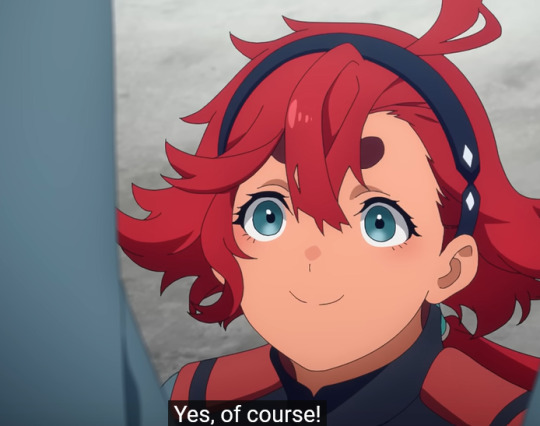
We move on to Episode 3, when Suletta changes during a phone call with Prospera before her second duel with Guel. I was tempted to dismiss this moment because, uh, she’s just changing. But I rewatched and holy moly. This scene is set right after the opening, and the very first shot? The floating headband.
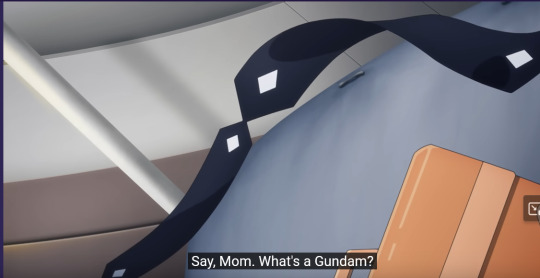
To refresh everyone’s memories, the conversation is about Suletta fretting about being accused of piloting a gundam. Suletta has no idea about the history of Gundams or her mom’s involvement in them. The hairband drifts about them ominously, not yet touching Suletta’s head.
Next: episode 4. Miorine’s and Suletta’s pre-bedtime talk. This is a very very important scene that sets both of their characters up. This is where they talk about their dreams and wants. For Miorine, she has no desires other than to escape everything. And for Suletta, she wants to build a school on Mercury. In this scene, Suletta is not wearing the headband.

Prospera had no plans nor ties to Mercury; it was merely a safe place to lay low from Benerit while she assembled a new identity, then she deposited her daughters there to gain xp while she was away on business. We never see Mercury, it’s only this scene in the show that we hear anything about it. But Mercury shaped almost everything about Suletta. Her eagerness to please, her loneliness, her resilience. Suletta’s dream here is independent of Prospera, emphasized later in ep 16 when Mio asks Suletta if she would give her school dream up for her mother. It's also significant that she pushes back confidently against Miorine telling her to live for herself. This is all Suletta and no mom.
Fast forward the show and the next Hairband Moment is more subtle, in episode 18. This is not a Suletta moment but an Elnora/Prospera one.

This is an extremely important shot for Prospera and Suletta’s relationship. Prospera hasn’t dyed her hair yet, and it’s free of the clips and the Hairband. This is her showing affection freely to Suletta and Suletta alone.
Elnora shed the hairband as part of her transformation into Prospera. She gave it to Suletta instead. Why? Look at the screenshot above again. At that age, Suletta wasn’t old enough to stop looking like Eri. We can assume the hairband was a gift later in Suletta’s life. Not only to differentiate her from Eri, but as a visual reminder for herself of Suletta’s purpose as the key to bringing Eri back. A visual reminder of all she lost as Elnora Samaya. No more, no less. Prospera cannot allow herself to falter in her plans.
Then, episode 19. Suletta has just had her heart mercilessly stomped on by ProspEri. She thinks her family has abandoned her. She’s not even a part of it, really, just a clone, a key. She’s not worthy of wearing Prospera’s gift. In her depressive slump, she’s finally taken it off. But it isn’t far away. She still loves them so, so, much.

Suletta has breakfast with the Earth House, caught with her hair down.
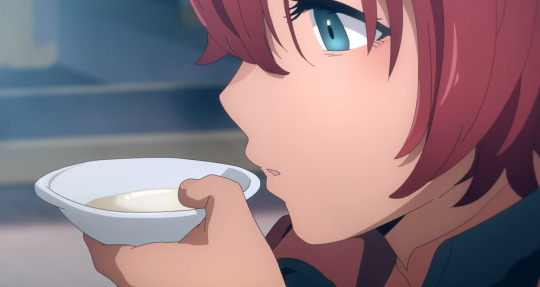
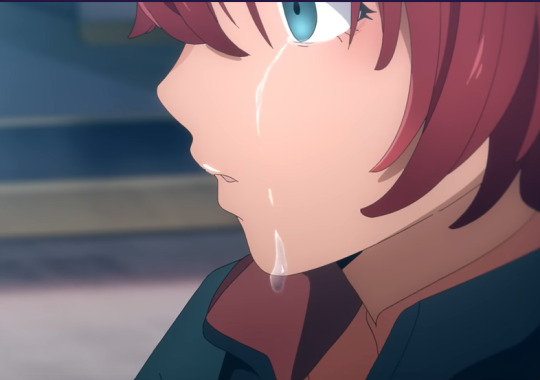
She’s not just a clone, a key, a discarded tool. She, on her own, has made friends. Friends separate from Samaya and Rembran’s dark bloody history. Found family who don’t push and prod at her for what happened, but support her warmly without expectation. Friends made from Suletta’s very innocent wishes for a shoujo school life. Friends that treat her as a person of her own. As others have pointed out, this is a Rebirth. This is Suletta Mercury realizing her self worth.
Her journey isn’t over yet.
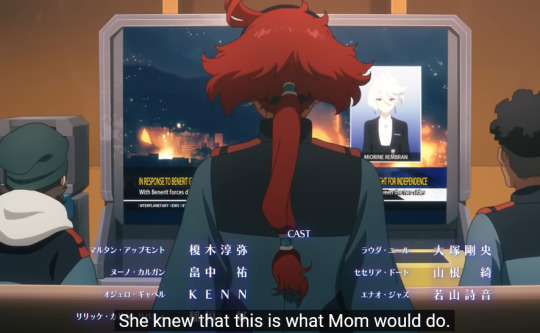
A disappointment to many, who would have expected Suletta breaking free for good and never wearing the thing again. A disappointment to me as well. I liked hair down Suletta.
So why is the hairband back? Because Suletta is realising the truth of her family in this scene. From hereon out, she acts with the full knowledge of the Samaya’s history. She’s connecting the dots between what Eri data storm-dumped in her brain, why she ejected her, why Mom left her floating in space, and what Prospera is doing now. Miorine isn’t brought up here despite being the one mentioned in the news. Suletta guessed from this news report that it was all ProspEri. She doesn’t think it’s the best way, but she knows why they did what they did. And that there was no other way they saw to keep her out of it.
For a time, Suletta, still a passive character, decided to take what good she could get out of the situation and do the only thing she thought she could do, what ProspEri (and Miorine) wanted: stay in school. Suletta has come to terms with her being a tool to the Samayas as well as the fact that she can’t help loving them.
Then an option to pilot a dangerous Gundam is given to her. With Petra’s words, seeing the devastation of the school and that caused by Quiet zero, personally working to save and comfort the students, and the final realisation that Ericht shielded her from dying to the Gundam curse all this time, Suletta gained a new resolve. She wants to talk to Prospera and Ericht again. Even if she’s not a Samaya. Even if she was only a tool to them. She loves. She wants.
“Take me there. To the Gundam.”
From there, the climax follows Suletta never backing down in her mission to appeal to Prospera and Ericht. Suletta cannot ignore what her family is doing; she dons the headband representing the Samayas and pilots Calibarn with purpose. Throughout the fight, she moves forward by telling Prospera and Ericht her wishes: for them to not go down the dark path, and to come with her instead. Eri reminds her that she has a place to be (with her new friends and Miorine), however, Suletta rebuts this: "I'm a greedy person! I still have so much I want to do with you and Mom!" She finally asserts herself as having a place in their lives. Ericht smiles at this unrelenting tenderness, making the choice to help Suletta AND spend the rest of her digital existence with her sister.
And the scene of Prospera, Eri and Suletta together in the data storm. At last, after 21 long years, Elnora sees her Vanadis family again. Suletta and Eri have brought it back using permet magic and her memories of them. We see Suletta’s helmet off, hairband prominent.

She and the data storm space embody the crossroads between moving forward and clinging to old ghosts, between life and death. Suletta makes no move to persuade Elnora either way, only telling her that whatever she chooses, even if the others disagree, Elnora’s choice has her support.
Despite being the originator of “move forward gain two”, Elnora has been trapped in guilt and grief. Nadim told her to run to save their daughter, but she died anyway. And there, 17 years ago, Elnora has been stuck since, neither running away nor moving forward.
Elnora decides, at this moment, that she doesn’t want to join the ghosts in the data storm. She and Eri both choose to live.
And the epilogue?

Elnora, Eri, and Suletta have found peace, a truly happy ending. The hairband is missing now. They’ve done it. They got what they wanted all along, even if it's not quite what they envisioned before. They’ve moved forward for each other and themselves.
I wonder if the best way to describe the hairband is the antithesis to "moving forward", the show's main theme. In some respects, it is. It embodies Prospera, Suletta (and Ericht's) earlier relationship. And yet by the end of this analysis it's also become what Suletta hangs on to throughout the confrontation to remind herself and the Samayas of the love that they did show to one another; the potential of their being a real family. By the end, suletta has grown up and helped others grow up too. She succeeded, moved beyond the old hair band, because her relationship with her family is progressing.
#g witch#gundam witch from mercury#mobile suit gundam: the witch from mercury#suletta mercury#prospera mercury#ericht samaya#elnora samaya#text post#long post#yeah this kinda turned into a mess#I don't think suletta will ever be a samaya. eri and elnora may become mercurys though#witch from mercury
79 notes
·
View notes
Text
Ever since I first watched Cowbell of Happiness, the idea of Nanami being a therian has been on my mind and I wanted to dig a little more into an alterhuman reading of her character.
Something I want to note first: I'm aware that Nanami being associated with animals has other symbolic meanings, especially within Nanami's Egg which is a rather blatant metaphor for puberty and sexuality. This interpretation is simply assigning an additional meaning to these elements. Also while I'm mainly tackling this from the angle of Nanami being a cow therian, this is really about her identifying as some flavour of non-human in general.
Now, I've suspected that Nanami is kinda weird and that part of the reason she antagonizes Anthy - besides her whole deal with Touga - is because in an attempt to uplift herself, she puts others down, since I saw the scene where she attempts to frame Anthy as a weirdo for keeping unusual animals.
And the cowbell episode did drive that impression home for me because. Yeah, Nanami is weird. It's said repeatedly in this episode.

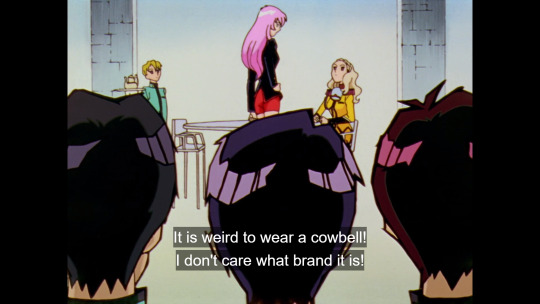
And even when it isn't outright stated, it's pretty clear what impression the bell has on the people around Nanami.
There's also something to be said about the comparison between Utena's masculine representation and Nanami proudly wearing the bell. Something about non-conformity and existing in a way that is weird or generally percieved as such.
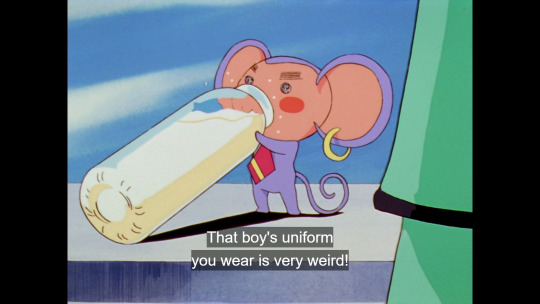


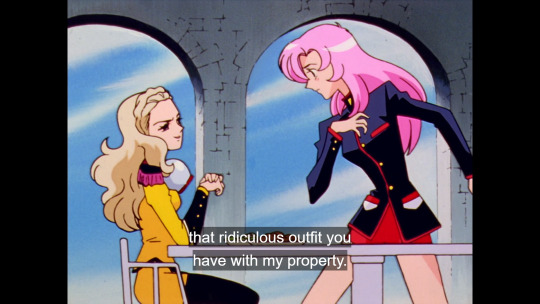
(Then again, Nanami is disillusioned with the bell as a status symbol, but that can also loop back to her putting those around her down to uplift herself.)
Another thing in the cowbell episode that stands out to me is this bit:


Like, Nanami, who's usually so on edge and concerned about everything around her, becomes calm and content after a while of wearing the cow bell? Wow that's interesting almost as if she allowed herself to be more true to herself instead of being uptight all the time huh.
Onto Nanami's Egg, while most of the episode serves as a metaphor for various adolescence experiences, I'm intruiged by this line:


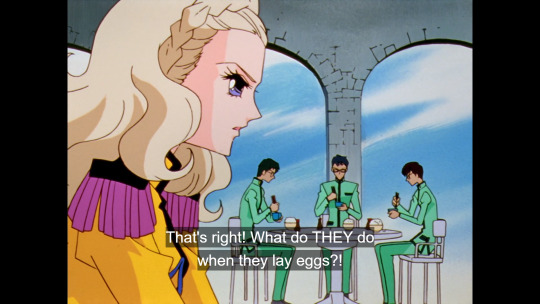
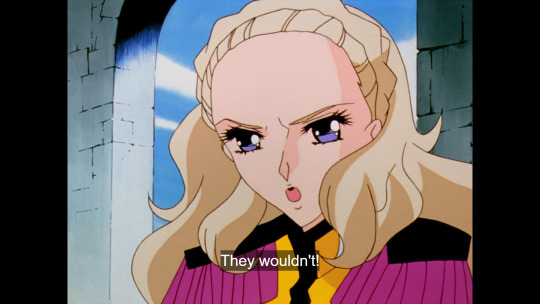
implying that there's yet another element to it that still alienates her from everyone else. On top of that, for a portion of the episode, Nanami is afraid of being seen as an alien

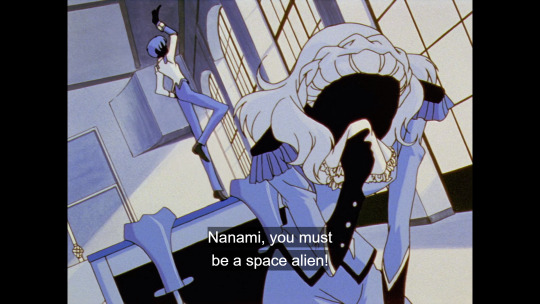

which also serves as a metaphor for experiences Nanami thinks are abnormal due to an apparent lack of understanding how puberty works, but the fact that it's implied the egg thing is actually unique to her and by the end of the episode she embraces the egg which then hatches an actual alien feels almost like... accepting that there is something strange (and non-human) about her.

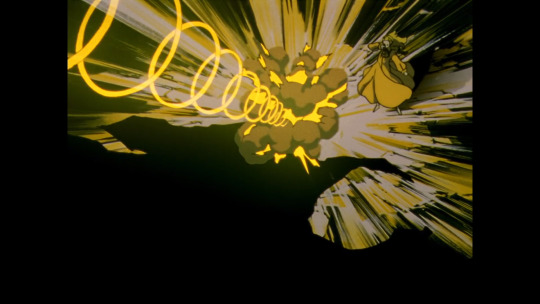
(And of course, how frequently Nanami is compared to animals in this episode once again. Mostly after she's played out a nightmare scenario due to a fear of judgement.)

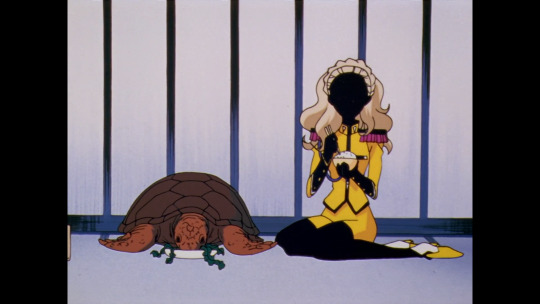


Lastly, a common interpretation I've seen of Nanami's singular appearance in the movie is that she escaped Ohtori and I agree with that. She only makes an indirect appearance as a cow in an "scandalicious" tape (because of course identifying with an animal, one as ungraceful as a cow no less, would be a scandal in the world of Ohtori Academy) and assuming she made it out and no longer feels the pressure to abide to social expectations, she can allow herself to be true to herself.

Also I know I'm cooking even more with water with this point than I already have with this entire post, especially considering silhouettes in RGU generally don't have mouth animations, but there's something about how Nanami doesn't have a mouth animation in her nightmare while her cow shadow does.
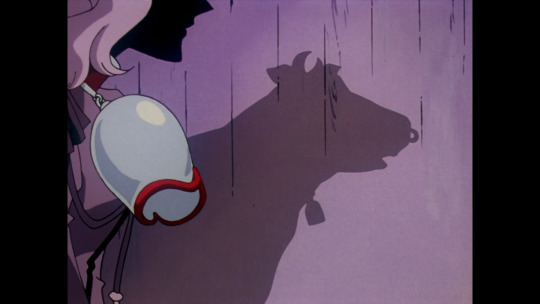
Thank you for reading my self-indulgent Nanami alterhuman analysis(??) that came out of a mixture of me recently coming to terms with being alterhuman and being a sucker for characters who have been dehumanized coming to terms with identifying as non-human (because I do think the animal/alien comparisons come from a place of fear of being dehumanized too).
#sorry for dissappearing for two days only to come back with fucking. nanami therian essay.#i got sick and had a terrible headache yesterday lol#utn#nanami tag#rgu meta#rgu#revolutionary girl utena#nanami kiryuu
20 notes
·
View notes
Text
(FFIX) Necron made sense as a final boss and here's why...
I would like to break down this argument by addressing his lines of dialogue in the original script (Japanese) because it's a better representation of who exactly Necron was and why he was there.
Necron only gained the name Necron in English. His japanese name is 永遠の闇 (Eternal Darkness) or 'The Darkness of Eternity.' I implore you to observe Necron as existential dread and death itself embodied in physical form.
The script (paraphrased to make more sense in English):
"Fear is in the hearts of all living things, from the moment they are given life; there is no exception. Life itself is a cruel thing... each abolishing the other in the struggle to survive. That which lives is constantly burdened by the anxiety and suffering caused by the fear that someday it will die. Upon realizing death is inescapable and cannot be overcome this fear is awakened... The greater the fear of death is, the more one will say he does not want to succumb to it. To be spared the enormous fear of death all life must cease to exist. Kuja gave into this fear and came to the conclusion that he could be saved by destroying the Crystal, the origin of everything."
Kuja was also afraid of death but more specifically, he was afraid of his life being meaningless, of not having control over his destiny and of the kind of life he lived.... before he ever knew about his shortened life span, this is why he sought to defy Garland so strongly.
Vivi, upon learning he was an artificial being made for war, started to question his own fate and consciousness. Throughout the game, he comes to the conclusion that it doesn't matter if he gets all the answers he wants - what matters is the choices he makes with the time he has. Vivi carved the life for himself that he wanted to live instead of succumbing to the dread of his shortened life span or his violent purpose for creation.
Zidane also learns he was an artificially created being made for destruction - at first this realization causes him to spiral as he thinks everything he knew about his life was a lie and that he has no control over his fate, that it was only by lucky chance he didn't come to kill everyone he now calls friends. His friends remind him that he is not defined by the purpose of his creation but rather the choices he makes and that he is in control of that.
I could go on.. almost every character in FFIX has this sort of theme (Garnet, Steiner, Freya, Beatrix, Kuja, the Black Mages, Mikoto even makes a speech about it after Kuja dies, etc.): Questioning the meaning of their existence, if the choices they made were right or wrong, if they are created for the wrong reasons or bound to a destiny that was handed to them OR if they have the ability to change and carve a new path for themselves.. if they are in control of their fate.
I say all of this to say, it is very important that all of the cast conquer their fear of death in order to live life without dreading the end of existence or what may or may not come after it. In defeating Necron they are saying: "We know that by choosing life we will not be spared it's hardships and that for all of us, death is inevitable, but the joy of experiencing being alive is a price we are willing to pay."
Necron states that he cannot actually be defeated when you finish fighting him because he is more of a metaphor for a feeling, for a reality of existing.
He was originally going to be represented as 'Hades' - god of the underworld - who is not actually a wicked force but a neutral force - one that anyone can greet with fear or acceptance.
Vivi, by his letter in the end, made peace with this reality and showed deeper understanding that some symbolic version of himself would live on in the lives of those he knew and the stories he told (memories).. this is how he kept Zidane's spirit alive despite never getting to see Zidane again in the flesh before (Vivi) passed.

Kuja, after witnessing the party defeat Necron and Kuja used the last of his remaining magic to teleport them to safety.

This line from Mikoto (talking for the Genomes) is a little tricky to translate to English. The real meaning of it from the original Japanese script is this message:
"Kuja.. what you did was wrong.. but you gave us all one thing.. hope. We were created for the wrong reason, but you alone defied our fate. We do not want to forget this. We want your memory to live on forever... for we want to believe that our existence has meaning."
What she's saying is: despite the fact that we were created for the wrong reason (to take over one planet and eradicate an existing people there) you alone challenged the idea that you had to live by someone else's design (Kuja wasn't following Garland's orders, he only wanted to appear that way to double cross him, but in reality he wanted to be the ruler of Terra and Gaia, not it's destroyer). Kuja was also told that he was 'a failed AoD' and Zidane made as a replacement which rendered his life meaningless initially - Kuja also defied this. He lived as an individual through and through. Kuja's memory reminds the Genomes (And the Black Mages) that they can choose their own meaning in life by the way they live and think despite any 'destiny' that might have been handed to them by their creation itself.
SO YES - Necron is the correct final boss.
And his foreshadowing is literally one of the largest themes of the game.
17 notes
·
View notes
Text
EUCLID ANALYSIS.
Part one -> Title and meaning
Part two -> You're already here!
Part three -> Line by line analysis part two
Part four -> Musical/intrumental notes
Part five -> The Night in Sleep Token
Part six -> Conclusion

“Just run it back, give me five whole minutes” → The song itself is five minutes and 13 seconds long, but Vessel only starts singing these lyrics at the 13-second mark. As the listener, you give him five whole minutes to say what he’s gotta say, but he still asks for more time. I see it as a representation of humanity. A set lifetime to do and say so many things, to change in so many ways, but it never seems to be enough.
A realisation, a revelation almost, develops across this song; change is inevitable, and that’s okay, and that having a set lifetime, having five whole minutes, is entirely what makes people human. What makes humanity.
“Thick tar on the inside burning” → This is a vivid description that can symbolise depression. Tar is a very viscous liquid that causes physical damage (rashes, headaches etc.) by merely touching it, plus, it’s very easy to get stuck in it; to let yourself be consumed by it, like depression. It’s used in literature as a metaphor to represent the feeling of being weighed down or emotionally trapped, afterall.
It could also be in reference to the visualisers for the whole album, which ends in a black liquid pouring out of the album art creatures.
“I’ve got a ghost in the hallway grinning” → This is both a callback to ‘The Apparition’, and a symbol for the past. Ghosts are relics of the past; haunting places and people they can’t let go of because they don’t know how, which means the Ghost in the hallway grinning can either be about Sleep, the people in Vessel’s past, or about Vessel himself.
Grinning is typically associated with joy, however, in this context, it adds a much more ominous feeling to the line. It implies that The Ghost is mocking Vessel with his past, finding amusement in his suffering at recalling what he wants to leave behind.
“And a heavy head that won't stop turning” → This describes how Vessel is burdened by his past that just won't leave him alone. He’s constantly kept awake by memories that taunt him, keeping him in a state of emotional turbulence.
“If my fate is a bad collision” → Callback to Granite and its foreboding theme of car crashes. ‘Bad collision’ suggests a sense of inevitability and a negative outcome. An argument in a car that goes a little bit too far and ends badly. However, what’s interesting is the comparison of fate with collisions; it illustrates the feeling of Vessel being caught up in circumstances beyond his control. His past, present and future are controlled (by Sleep) and he can do absolutely nothing about it.
“And if my mind is an open highway” → This line flows perfectly with the previous lyric. In contrast to the presented idea of fate as a collision, this line portrays Vessel’s mind as a vast, open space symbolised by a highway. Highways are typically associated with freedom, movement, and endless possibilities, but, matched with the previous line, the freedom becomes terrifying because of the way Vessel has spent his known life following fate. It becomes predestination versus free will. Divinity versus humanity. Lore-wise, it creates a perfect representation of Vessel as a vessel; a human holding a God inside his body and having to deal with it.
“Give me the twilight two-way vision” → Yet again, lyrically, duality is brought back. Twilight is the transition zone between day and night and it symbolizes mystery and threshold between opposing states. The choice of twilight over sunset or dawn, for example, suggests a desire for a moment of transition, change, as opposed to the stark clarity of daylight or the complete darkness of night. Vessel does not want the past, daylight, but he does not want his present either (night).
Further, The term ‘two-way vision’ introduces the idea of seeing life from two different perspectives, which could be about Vessel’s past and present self, Vessel and his partner, or Vessel and Sleep. The concept of this dual vision implies the recognition of the coexistence of opposites. It could also be in reference to Higher’s “‘Cause I look for scarlet and you look for ultraviolet”.
“Give me one last ride on a sunset sky lane” → The phrase ‘one last ride’ implies a sense of finality or a farewell, which links to the theory that Euclid is a eulogy above all things. Vessel is asking for one last good thing before he leaves– changes– for good. A change between day and night is yet again brought up here; sunsets bring the night, which “comes down like Heaven”; it’s the last few minutes of time Vessel has to himself before he has to devote the Holy hours of the night to Sleep. The end of the day is a time often associated with reflection, and contemplation and is one of the transitions from day to night, which is also right before twilight.
“Call me when you get the chance” → Can either interpreted as a message from Vessel to his partner, to Sleep or vice versa. The echo-y effect placed on the lyric makes it feel almost like a voicemail as well.
“I can feel the walls around me closing in” → With this lyric, the previous line can now be interpreted as a plea for help. A ‘Please help me, but only if I’m not an inconvenience. I know we are not what we were, but I need your comfort again’.
Further, walls built up around people are typically used as symbolism for boundaries; metaphorical walls put up around a person to stop them from getting hurt. Vessels’ walls are collapsing in on him because he’s changing and learning how to trust again (which is good), but it scares him enough for him to try and go back to the past. Go back to the ghost in the hallway grinning. Overall, it creates a very claustrophobic and visceral image.
“Just running forwards, a life like wires” → Wires, robots and algorithms are referenced a multitude of times throughout the whole album, which this lyric carries on. Despite it all, the vessel is running through the complicated mess of wires that is life. To quote Genius; ‘the path taken has been inevitable. The wires will continue to carry the circuit forward, and instances of life are inevitable, similar to how some view life as being ‘written in the stars’’. Which means, again, fate and predestination are being referenced.
“As I see the past on an empty ceiling” → Vessel’s memories continue to haunt him, no matter how far he runs from them. However, Vessel is still running despite it all. He’s accepting the limited amount of time he has as well as that whatever has happened is in the past now.
Plus, an empty ceiling quite literally suggests moving out and moving on; the bare ceiling which doesn’t have all the familiar stains on it reflects what once was like a mirror for him.
#I think about all of these too much#I can't tell if I drove myself past the point of no return doing this or if I just finally fully indulged in one of my Roman Empires#if any of you are reading this are getting the vibe of slow building insanity off of this it's because I wrote most of it late and night ->#in my free time when I couldn't sleep#but 'give me one last ride on a sunset skylane' hits me in the chest#hard#it feels so horribly final and I ain't even the one this guy is saying goodbye to#sleep token#st#mel's rambles#euclid sleep token#euclid#take me back to eden#sleep token tmbte#tmbte#sleep token analysis#vessel#vessel sleep token
10 notes
·
View notes